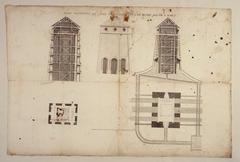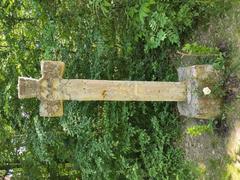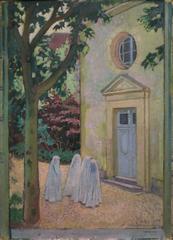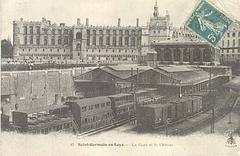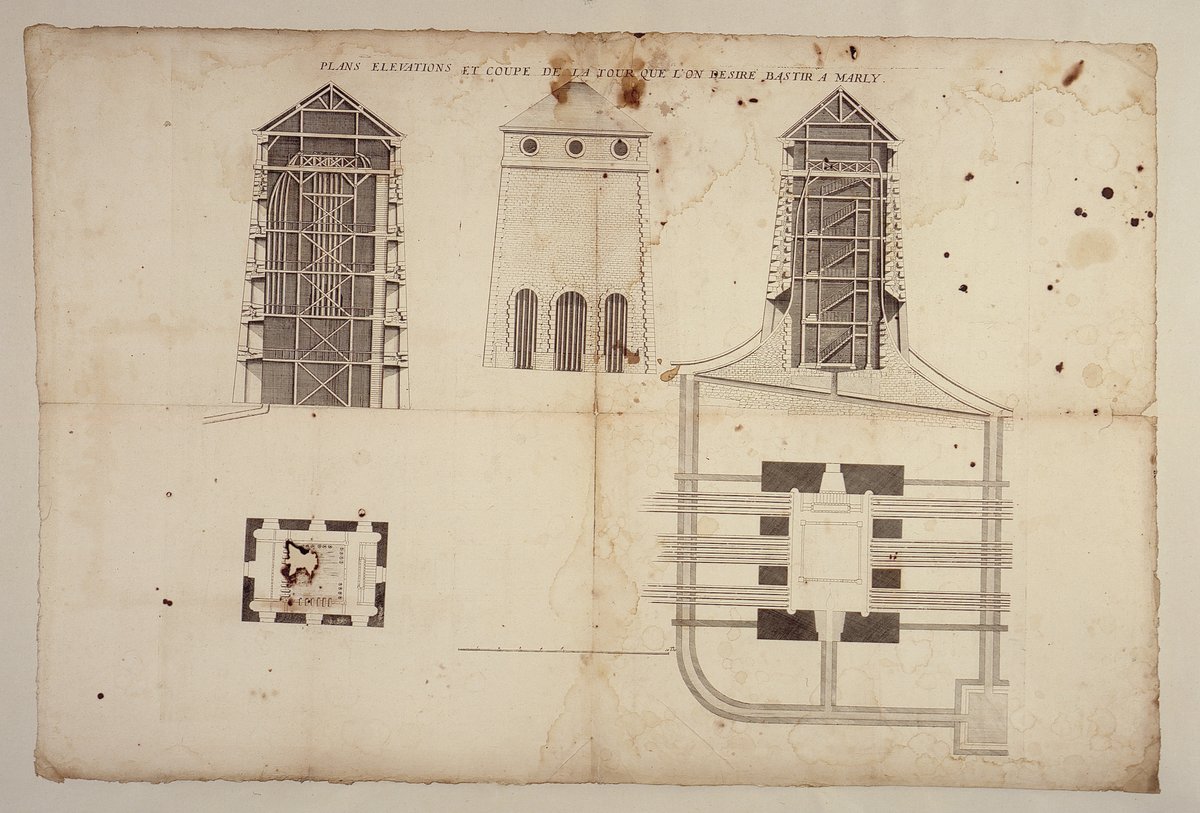
Aqueduct Louveciennes: Visiting Hours, Tickets, and Historical Insights
Date: 01/08/2024
Introduction
The Aqueduct Louveciennes, a remarkable 17th-century engineering marvel, stands as a testament to the grandeur and ambition of Louis XIV’s reign. Constructed to supply water to the Château de Versailles and the Château de Marly, this historical monument embodies the advanced technological achievements of its era. Designed by Jules Hardouin-Mansard and completed in 1684, the aqueduct spans approximately 643 meters and features 36 arches, showcasing both functionality and aesthetic elegance. Its role within the larger hydraulic system known as the Machine de Marly highlights the innovative spirit of the time, with 14 water wheels and 257 pumps working in unison to elevate water from the Seine River to the royal estates (Complete France, France This Way).
Today, the Aqueduct Louveciennes attracts visitors with its historical significance and picturesque setting in the town of Louveciennes, easily accessible from Paris. This guide provides comprehensive information on the history, visiting hours, ticket prices, travel tips, and nearby attractions, ensuring a well-rounded and enriching experience for all visitors.
Table of Contents
History of the Aqueduct Louveciennes
Construction and Purpose
The Aqueduct Louveciennes, also known as the Aqueduct of Louveciennes, was constructed in the late 17th century under the reign of Louis XIV. The primary purpose of this monumental structure was to supply water to the Château de Versailles and the Château de Marly, two of the most significant royal residences of the time. The aqueduct was part of a larger hydraulic system known as the Machine de Marly, which was designed to pump water from the Seine River to the elevated reservoirs that fed the fountains and gardens of these châteaux.
The aqueduct itself spans approximately 643 meters and consists of 36 arches. Its design was both functional and aesthetically pleasing, reflecting the grandeur and opulence of Louis XIV’s reign.
The Machine de Marly
The Machine de Marly played a crucial role in the operation of the Aqueduct Louveciennes. This system, designed by engineer Arnold de Ville, was among the most advanced technological achievements of the 17th century. It consisted of 14 water wheels, each 12 meters in diameter, which powered 257 pumps to lift water from the Seine River to the aqueduct.
The water was then transported through the aqueduct to the reservoirs at Louveciennes, from where it was distributed to the gardens and fountains of Versailles and Marly. The entire system required constant maintenance and a large workforce to operate but was essential for maintaining the lush gardens and elaborate water features that were a hallmark of Louis XIV’s royal estates.
Historical Significance
The Aqueduct Louveciennes and the Machine de Marly are significant not only for their engineering prowess but also for their cultural and historical impact. These structures symbolize the grandeur and ambition of Louis XIV’s reign, often referred to as the Sun King. The ability to control and manipulate water on such a grand scale was a demonstration of the king’s power and the technological advancements of the time.
The aqueduct and the hydraulic system also played a role in the development of hydraulic engineering and influenced future projects in France and beyond. The success of the Machine de Marly and the Aqueduct Louveciennes showcased the potential of large-scale water management systems, paving the way for future innovations in the field.
Decline and Preservation
The Aqueduct Louveciennes and the Machine de Marly remained in operation for over a century, but their use declined in the 19th century as new water supply systems were developed. The advent of modern plumbing and the construction of new reservoirs reduced the reliance on the aqueduct, and it eventually fell into disrepair.
Despite its decline, the aqueduct has been preserved as a historical monument. In 1862, it was classified as a historic monument by the French government, recognizing its architectural and historical significance. Today, the aqueduct stands as a testament to the ingenuity and ambition of 17th-century engineers and remains a popular tourist attraction.
Visitor Information
Visiting Hours
The Aqueduct Louveciennes is open to visitors from 9 AM to 6 PM daily.
Tickets
Entry to the aqueduct is free. Guided tours are available for a fee.
How to Get There
Louveciennes is easily accessible from Paris by train or car. Trains run regularly from Paris Saint-Lazare to Louveciennes station.
Guided Tours
Guided tours are available and highly recommended for those who want to learn more about the history and significance of the aqueduct. These tours often provide insights that you might miss on a self-guided visit. Check the local tourism office or online resources for tour schedules and availability.
Travel Tips
To make the most of your visit to the Aqueduct Louveciennes, consider visiting during the spring or autumn months when the weather is mild. Wear comfortable walking shoes, as the terrain can be uneven. Bringing a camera is a good idea to capture the stunning views and architectural details.
Accessibility
The site is partially accessible to visitors with disabilities. While some areas may be challenging to navigate due to uneven ground, efforts have been made to accommodate all visitors. It is recommended to contact local tourist information centers for detailed accessibility information.
Nearby Attractions
Louveciennes and the surrounding area offer several other attractions that can be combined with a visit to the aqueduct:
- Versailles Palace: Located just 6 kilometers from Louveciennes, the Palace of Versailles is one of the most famous landmarks in France. It is a must-visit for its opulent architecture and beautiful gardens (France This Way).
- Saint-Germain-en-Laye: This nearby town is home to the Château de Saint-Germain-en-Laye, a historic royal residence. The town also offers beautiful parks and gardens, such as the Domaine National de Saint-Germain-en-Laye (Complete France).
- Marly-le-Roi: Just south of Saint-Germain-en-Laye, Marly-le-Roi is known for its connections with Louis XIV. The Domaine National de Marly offers walking, biking, and horse-riding trails, as well as the Marly-le-Roi-Louveciennes museum (Complete France).
Local Amenities
- Restaurants and Cafes: Louveciennes has a variety of dining options ranging from casual cafes to more formal restaurants. Local cuisine often features traditional French dishes, and many establishments offer outdoor seating during the warmer months.
- Accommodation: If you plan to stay overnight, there are several hotels and guesthouses in Louveciennes and the surrounding towns. Booking in advance is recommended, especially during peak tourist seasons (France This Way).
- Shops and Markets: Louveciennes has a few local shops and markets where you can buy souvenirs, local produce, and other goods. Visiting a local market can be a delightful experience, offering a glimpse into the daily life of the residents.
Safety Tips
- Stay on Marked Paths: While exploring the aqueduct and its surroundings, it’s important to stay on marked paths to avoid any potential hazards.
- Weather Preparedness: Check the weather forecast before your visit and dress accordingly. Bring an umbrella or raincoat if rain is expected.
- Hydration and Sun Protection: During the warmer months, ensure you stay hydrated and use sun protection such as sunscreen, hats, and sunglasses.
Cultural Etiquette
- Respect the Site: The aqueduct is a historical monument, so it’s important to treat it with respect. Avoid climbing on the structure or causing any damage.
- Local Customs: While Louveciennes is a tourist-friendly area, it’s always good to be mindful of local customs and etiquette. A simple “Bonjour” (hello) and “Merci” (thank you) go a long way in making a positive impression.
FAQ
Q: What are the visiting hours for the Aqueduct Louveciennes? A: The aqueduct is open daily from 9:00 AM to 6:00 PM.
Q: Is there an entrance fee? A: Entry to the aqueduct is free, but guided tours are available for a fee. It is recommended to book these tours in advance.
Q: How to get to the Aqueduct Louveciennes? A: The site is accessible via train from Paris Saint-Lazare to Louveciennes station, or by car via the A13 motorway.
Conclusion
The Aqueduct Louveciennes remains a monumental symbol of 17th-century engineering and the opulence of Louis XIV’s reign. Its historical and architectural significance, coupled with its picturesque location, make it a compelling destination for tourists and history enthusiasts alike. Visitors can explore the aqueduct’s intricate design, learn about its role in the grand hydraulic system of the Machine de Marly, and appreciate the historical context of its construction and operation. The preservation efforts and the status as a protected historical monument ensure that the Aqueduct Louveciennes will continue to be a valuable educational and cultural site for future generations (Triplyzer).
For a memorable visit, plan your trip during the mild spring or autumn months, take advantage of guided tours, and explore the nearby attractions such as the Palace of Versailles and the town of Saint-Germain-en-Laye. By following the travel tips and safety guidelines provided, you can fully appreciate the beauty and historical importance of this remarkable site. Stay updated with the latest information and events by following our social media channels and downloading our mobile app Audiala.
References
- Complete France. (n.d.). 10 reasons to visit Saint-Germain and Boucles de Seine. Retrieved from Complete France
- France This Way. (n.d.). Louveciennes. Retrieved from France This Way
- Triplyzer. (n.d.). Things to do in Saint-Germain-en-Laye. Retrieved from Triplyzer
